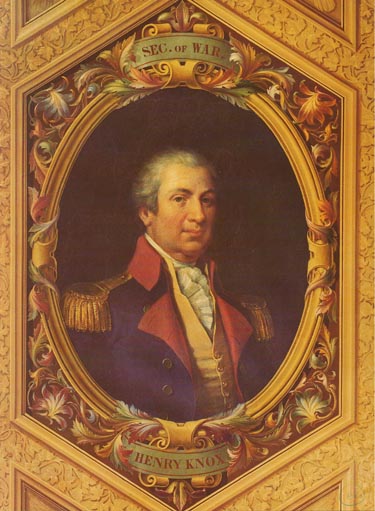
Henry Knox was born in Boston, Massachusetts, on 25 July 1750; upon his father’s death, left school at age twelve to work in a bookstore; joined a local military company at eighteen, was present at the Boston Massacre, 1770, and joined the Boston Grenadier Corps, 1772; married Lucy Flucker in 1774; joined the patriot cause and offered his services to General Washington, 1775; was commissioned colonel of the Continental Regiment of Artillery; led the expedition to transfer captured British guns from Fort Ticonderoga to Boston, 1776, a move that forced the British to evacuate the city; led the Delaware River crossing and participated in the battle of Trenton, 1776; was promoted to brigadier general and chief of artillery of the Continental Army, December 1776; participated in the battles of Princeton, Brandywine, and Germantown in 1777 and Monmouth in 1778; sat on the court-martial of Major John André, 1780; placed the American artillery at the Yorktown siege, 1781; commanded the West Point post, 1778–1783; organized the Society of the Cincinnati, 1783; was the senior officer of the United States Army, 23 December 1783–20 June 1784; served under the Confederation as secretary at war, 8 March 1785–11 September 1789; served under the Constitution as the first secretary of war, 12 September 1789–31 December 1794; prepared a plan for a national militia, advocated and presided over initial moves to establish a regular navy, urged and initiated the establishment of a chain of coast fortifications, and supervised Indian policy; returned to Thomaston, Maine, in 1796; engaged in lumbering, shipbuilding, stock raising, and brick manufacturing; died in Thomaston on 25 October 1806.
The Artist
Constantino Brumidi (1805–1880) was born in Rome, Italy, where he later studied art under Vincenzo Camuccini, Antonio Canova, and Bertel Thorvaldsen. He painted the portrait of Pope Pius IX and assisted in the restoration of the Raphael frescoes in the Vatican Loggia. As a captain of the Papal Guards he became involved in the political disturbances of 1848 and fled to America after a brief period of imprisonment. In Washington, D.C., to complete his naturalization, Brumidi met and was retained by Captain Montgomery C. Meigs, superintendent of the United States Capitol. The artist embarked upon a quarter of a century of work in the building, executing historical paintings, allegorical scenes, and portraits of public figures. His fresco portrait of General Henry Knox adorns the President’s Room of the Senate wing, and is reproduced from the United States Capitol Collection.
Henry Knox
By Constantino Brumidi
Mural medallion portrait, post-1859
[50]

[51]
page updated 30 April 2001